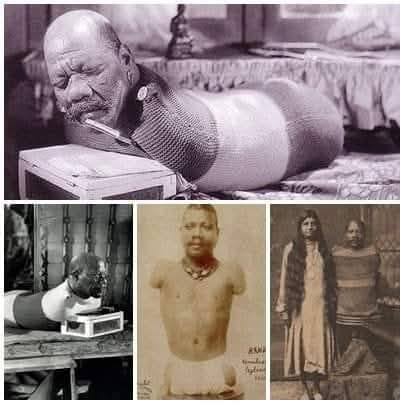Absolutely! Here’s a more vivid and extended version of the passage that brings Prince Randian’s story to life with a richer narrative and more compelling storytelling:—Prince Randian: The Remarkable Journey of the Living TorsoIn the vibrant, unpredictable world of early 20th-century sideshows and traveling circuses, few figures captured public fascination quite like Prince Randian, also famously known as The Living Torso or the Human Caterpillar. Born in British Guiana (now Guyana) in 1871 to Indian indentured laborers, Randian came into the world with a rare condition known as tetra-amelia syndrome — a congenital disorder that left him without arms or legs. Yet, what society viewed as a severe limitation, Randian transformed into a symbol of resilience, ingenuity, and unshakable human spirit.Discovered in 1889 by the legendary showman P.T. Barnum, Randian was brought to the United States, where he would go on to spend decades performing in American sideshows. His physical condition drew crowds, but it was his extraordinary skill, charisma, and defiant self-sufficiency that left audiences truly astounded.Randian’s act was unlike anything people had seen. He would enter the stage dressed in a woolen, cigar-shaped suit, wriggling and twisting his body with uncanny dexterity, often crawling across the floor like a serpent or caterpillar — a performance that earned him his monikers. But beyond the spectacle, he performed jaw-dropping demonstrations of personal independence: shaving with a straight razor, painting, writing, and even rolling and lighting cigarettes with his lips and shoulders — all without assistance.This display of skill not only stunned audiences but also challenged their perceptions of disability. He was not just a novelty — he was a master of adaptation and persistence, someone who refused to be defined by what he lacked.Fluent in English, German, French, and Hindi, Randian often conversed fluently with spectators from diverse backgrounds, bringing an intellectual dimension to his act that made him even more engaging. His intelligence and charm were just as disarming as his physical feats.Offstage, Prince Randian was a devoted family man. He married and fathered four children, creating a life that defied the odds. He was also rumored to be skilled in carpentry, and while his joke about building his own house may have been made in jest, it symbolized the same determination and humor that fueled his life and career. Friends and fans remembered him as warm, clever, and unfailingly optimistic.Throughout his life, Randian faced not only the challenges posed by his condition but also the harsh realities of racial discrimination and ableism in a time when both were pervasive. Despite these barriers, he managed to achieve a level of success and visibility that was extraordinary for a man of color and disability in his era.He remained a fixture in the sideshow circuit well into his later years, even appearing in the 1932 cult classic film “Freaks” — a rare cinematic glimpse of his talents, where he famously rolls and lights a cigarette on screen, astonishing viewers even today.Prince Randian died in 1934 at the age of 63, leaving behind a legacy that extended far beyond the tented walls of the circus. His story is not just one of survival, but of triumph against deeply rooted odds — a man who turned a life that others may have viewed as tragic into a testament of resourcefulness, humor, and human potential.In the annals of sideshow history, Prince Randian remains a legendary figure — not just because of his physical uniqueness, but because of the spirit that carried him through a world built to doubt him, and the dignity with which he carved out his place in it.
